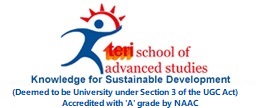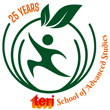
ANNOUNCEMENTS

| Date | News Title | Source |
| 18-July-2025 | 1 in 4 Indian married couples ... | The Indian Express |
| 23-June-2025 | Blended Learning: Driving educ... | The Pioneer |
| 22-June-2025 | All adults overweight in every... | |
| 21-June-2025 | TERI SAS Nurturing Global Sust... | The Interview World (Online) |
| 27-May-2025 | Eco-education trend grows: Sus... | India Today (Online- Education Desk) |
| 25-March-2025 | How water green credits can fu... | Hindustan Times (Opinion) |
| 23-February-2025 | Sustainable biz practices disc... | The Times of India (Online) |
| 21-February-2025 | Sangam fit for bath’, Enviro... | News9 (Online) |
| 12-February-2025 | A role for India in South-Sout... | The Hindu (Online) |
| 02-December-2024 | ICAR Findings Show 34% Decline... | ETV Bharat (Online) |
Dirty water and muck have accumulated in the 23 wastewater ponds in the rural areas of the district over the years, impacting groundwater recharge, said the officials
Twenty-three wastewater ponds in rural areas of Gurugram district are being revived to facilitate groundwater recharge and ensure long-term benefits to locals, said representatives of GuruJal on Monday.
GuruJal is an integrated water management initiative of the district administration which focuses on tackling water scarcity, groundwater depletion, flooding, and water stagnation in Gurugram.
“We are currently working on rejuvenating 23 wastewater ponds in the rural areas of the district, where dirty water and muck have accumulated over the years, impacting groundwater recharge. This water first needs to be treated and then the pond can be refilled. The technology used to treat the water will be decided after the water is sent to authorised labs for testing,” said Osho Kalia, a senior member of GuruJal.
“Locals will also be involved in the projects as we request them to take care of these ponds in the long run,” Kalia added.
These 23 ponds include wastewater ponds in Iqbalpur, Khentawas, Daula, Mojabad, Bhorakalan, Nawada, Budhera, Daultabad, Bilaspur, Tajnagar, Hariahera, Palasoli, Kasan, Wazirpur, Chandla Dungerwas, Dharampur, Binola, Goriawas, Bhaganki, Bhorakalan, Bilaspur Kalan, Mankrola and Syed Mohamamdpur.
These ponds have different timelines for completion, with work at some ponds like Mojabad being completed and currently in the monitoring stage, said representatives from GuruJal. The rejuvenation work for all the ponds is likely to be completed by next year.
The technologies to be used to treat the water include root zone technology (a natural treatment process wherein water is purified using the roots of plants), bio-filter technology (wherein waste water is filtered using biofilters like sand, gravel, or other filter medium grain, which are covered with biofilms--thin layer which has bacteria and microorganisms. These biofilms help break down the organic matter in the waste water, which is then released into the pond), advance eco-reactor technology, and dewatering), advance eco-reactor technology (a green alternative to waste water treatment, where organic and inert substance is mixed in specific formulation which creates an ecosystem with microbes, enzymes, worms that treats the waste water) and dewatering (wherein all the waste water from the pond is removed using machines to clean the bottom layer of the pond).
According to authorities, these ponds have turned into wastewater ponds because sewage, waste from cattle, dirty water from households is dumped here. Due to this, a layer of muck has formed at the bottom of these ponds, which prevents water from percolating into the ground.
Kalia said that the ponds will first be dewatered and desilted and a mini wastewater treatment plant will be installed at the pond. All water sources from the village will be connected to this plant, so that in the future only treated water is released into the water bodies.
Shiv Singh Rawat, superintending engineer of irrigation and water resources, Gurugram, said, “Initially there was no concept of wastewater ponds as water from wells or ponds was utilised and the ground would soak in the rest because of less concretisation. But over the years, wastewater generated from households was released into the ponds, polluting the existing water there. Now, with these projects, village-specific solutions are being provided, which will help the groundwater table recharge.”
According to the records of the district administration, a population of over 200,000 is dependent on some of the ponds, such as those in Daula, Mojabad and Khentawas.
At the pond in Daula, Sohna block, where authorities are using root zone technology, 17,321 kilolitres of water can be recharged every year by treating 91,250 kilolitres of wastewater. At Mojabad’s pond in Pataudi block, where the same technology is being used, 15,300 kilolitres of water can be recharged every year, authorities said. At Khentawas pond in Farrukhnagar block, 26,397 kilolitres of water can be recharged every year. At Daulatabad pond, 50465 kilolitres of water can be recharged every year.
GuruJal installed a piezometer at the Mojabad pond in 2020, and the team said it is planning to install more such meters at every pond under the Atal Bhujal Yojana, a central scheme for water conservation. A piezometer is a device that can measure the groundwater level and give daily updates.
In January 2020, the groundwater level at the Mojabad pond was 39.5m. In two years, the water level at this pond has increased by two metres and was measured at 37.2m on Friday morning, authorities said.
Experts working on groundwater conservation, however, said that these systems can work in the long run only if the community is involved.
Fawzia Tarannum, assistant professor, department of regional water studies, TERI School of Advanced Studies, said that these technologies can work for up to 15-20 years, helping groundwater recharge, providing water for cattle and agricultural use, only provided there is a proper maintenance mechanism.
“Be it root zone or bio-filter technology, the important factors to be considered prior to installation are the estimation of the total wastewater generation, proper forecasting of increase in wastewater, choosing the right technology depending on the quality of wastewater, efficiency of the treatment system, and a sustainability plan for operation and maintenance. A community-based planning and governance system should be instituted prior to commencing the project. Community should not be looked at as just the beneficiaries but should be considered as equal partners in decision-making and implementation of the project. Outreach programmes must be undertaken to understand the community dynamics and to bring them on board. For effective participation, it is important for community to understand the benefits that they shall derive from the project. Pond rejuvenation should actually be a social, cultural, ecological and recreational revival. Ecosystems with recreational spots, benches or community spaces can be made, so that people feel the need to preserve the water body,” said Tarannum.
Plot No. 10, Institutional Area, Vasant Kunj, New Delhi - 110 070, India.
Tel. +91 11 71800222 (25 lines).
Website : www.terisas.ac.in
Email id : registrar@terisas.ac.in
© Copyright © 2025, TERI SAS, All rights reserved.
Visitors No.: 46543083 Since 2023


